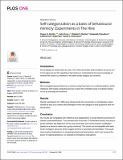Files in this item
Self-categorization as a basis of behavioural mimicry : experiments in The Hive
Item metadata
| dc.contributor.author | Neville, Fergus G. | |
| dc.contributor.author | Drury, John | |
| dc.contributor.author | Reicher, Stephen David | |
| dc.contributor.author | Choudhury, Sanjeedah | |
| dc.contributor.author | Stott, Clifford | |
| dc.contributor.author | Ball, Roger | |
| dc.contributor.author | Richardson, Daniel | |
| dc.date.accessioned | 2020-11-02T12:30:08Z | |
| dc.date.available | 2020-11-02T12:30:08Z | |
| dc.date.issued | 2020-10-30 | |
| dc.identifier | 270685505 | |
| dc.identifier | 6af2a5e6-870a-483d-8865-98c4d612615d | |
| dc.identifier | 85094982576 | |
| dc.identifier | 000588368900039 | |
| dc.identifier.citation | Neville , F G , Drury , J , Reicher , S D , Choudhury , S , Stott , C , Ball , R & Richardson , D 2020 , ' Self-categorization as a basis of behavioural mimicry : experiments in The Hive ' , PLoS One , vol. 15 , no. 10 , e0241227 . https://doi.org/10.1371/journal.pone.0241227 | en |
| dc.identifier.issn | 1932-6203 | |
| dc.identifier.other | ORCID: /0000-0001-7377-4507/work/83086232 | |
| dc.identifier.uri | https://hdl.handle.net/10023/20880 | |
| dc.description | JD, SR and CS received grant ES/N01068X/1 from the Economic and Social Research Council (https://esrc.ukri.org/). | en |
| dc.description.abstract | Introduction Do we always do what others do, and, if not, when and under what conditions do we do so? In this paper we test the hypothesis that mimicry is moderated by the mere knowledge of whether the source is a member of the same social category as ourselves. Methods We investigated group influence on mimicry using three tasks on a software platform which interfaces with mobile computing devices to allow the controlled study of collective behaviour in an everyday environment. Results Overall, participants (N = 965) were influenced by the movements of confederates (represented as dots on a screen) who belonged to their own category in both purposive and incidental tasks. Conclusion Our results are compatible with collective level explanations of social influence premised on shared social identification. This includes both a heuristic of unintended mimicry (the acts of group members are diagnostic of how one should act), and communication of affiliation (based on a desire to make one’s group cohesive). The results are incompatible with traditional ‘contagion’ accounts which suggest mimicry is automatic and inevitable. The results have practical implications for designing behavioural interventions which can harness the power of copying behaviour, for example in emergency evacuations. | |
| dc.format.extent | 17 | |
| dc.format.extent | 1114208 | |
| dc.language.iso | eng | |
| dc.relation.ispartof | PLoS One | en |
| dc.subject | Mimicry | en |
| dc.subject | Social influence | en |
| dc.subject | Social identity | en |
| dc.subject | Self-categorization | en |
| dc.subject | Shared social identification | en |
| dc.subject | Shared identity | en |
| dc.subject | Heuristics | en |
| dc.subject | Contagion | en |
| dc.subject | BF Psychology | en |
| dc.subject | DAS | en |
| dc.subject.lcc | BF | en |
| dc.title | Self-categorization as a basis of behavioural mimicry : experiments in The Hive | en |
| dc.type | Journal article | en |
| dc.contributor.sponsor | Economic & Social Research Council | en |
| dc.contributor.institution | University of St Andrews. School of Management | en |
| dc.contributor.institution | University of St Andrews. School of Psychology and Neuroscience | en |
| dc.identifier.doi | https://doi.org/10.1371/journal.pone.0241227 | |
| dc.description.status | Peer reviewed | en |
| dc.identifier.grantnumber | ES/N01068X/1 | en |
This item appears in the following Collection(s)
Items in the St Andrews Research Repository are protected by copyright, with all rights reserved, unless otherwise indicated.

